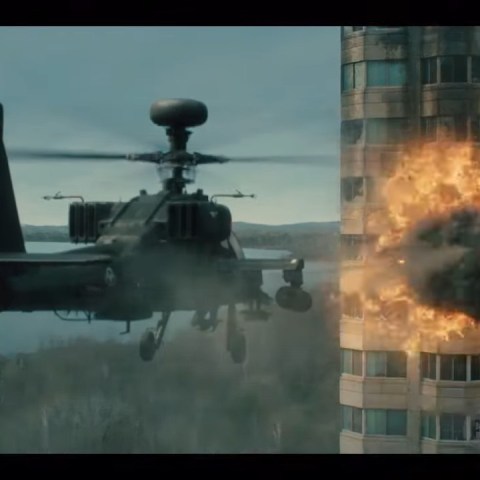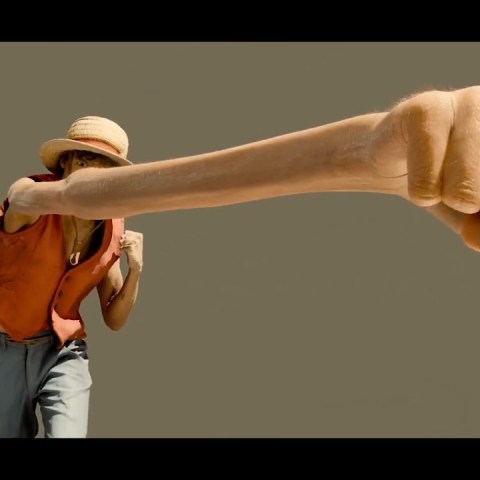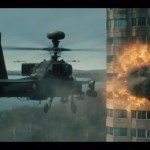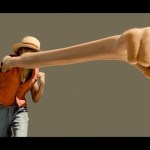Plus, how the VFX studio enabled Rory Kinnear to play all the men in ‘Men’.
***Note: this article contains major plot spoilers***
Alex Garland’s Men contains one of the most shocking sequences in a film in recent memory when a series of men, all ‘played’ by actor Rory Kinnear, violently give birth one after another. The same men had just spent days terrorizing Harper (Jessie Buckley) in and around an English countryside manor house. The sequence was made possible with live-action photography, enhanced prosthetics and practical special effects, and digital visual effects work by Framestore.
And if that birthing sequence is not crazy enough, Framestore was also called upon to deliver a range of other disturbing visual effects for the film, including a moment when Jessie cuts one of the man’s arms and splits it in two, which stays that way for several scenes. There’s also the elaborate VFX that were required to turn Rory Kinnear into several of the ‘men’, most notably the young boy Samuel via meticulous face replacement.
In this befores & afters interview, visual effects supervisor David Simpson details Framestore’s extensive and somewhat unusual work for Men.
Rory Kinnear is…everywhere
b&a: This really must have been one of more unusual visual effects experiences for you and your crew. Let’s start with the characters all played by Rory Kinnear. How did you approach that?
David Simpson: So, the script didn’t mention that they’re all the same person. I read the script and assumed that they would all be separate actors. Then in the first meeting that I had, Alex dropped the bombshell that they’re all going to be played by the same guy, which adds, obviously, a degree of complexity to it, especially with the character of Samuel.
For most of the characters, it’s Rory in a completely different costume. He has a wig change and then a make-up change, then comes back to set, which in itself is its own kind of challenge. For instance, the pub sequence, these are straightforward splitscreens, but it takes an hour and a half for him to change make-up and change costume. So, you have to shoot every angle in that scene with him as the policeman, say, acting with stand-ins. He then goes away for an hour and a half, and then we re-create the camera angles. We laboriously and extensively marked up every position, height, down to the millimeter, so we could get the cameras back into position. Then Rory would come back now dressed as Geoffrey, and we’d do the whole scene again.
The real challenge was Samuel. It was probably one of the first things we started doing and one of the last things we finished. It’s purely because there’s so much that you don’t necessarily think about in it.
b&a: Here you’re putting Rory’s face on the younger kid. What were the different ways you discussed how that would be done?
David Simpson: We talked about a lot of different options. We talked about doing deepfakes. You could take Rory’s face and transplant it onto Zak Rothera-Oxley’s performance (Zak being the actor who plays Samuel). But Alex was quite keen on Rory shaping all of the characters and having control over the characters’ performance. So, he didn’t want to do that. We wanted it to be very much Rory’s performance on Samuel’s body. So, we couldn’t really use deepfakes.
We even talked about doing oversized sets and doing it a bit like Eternal Sunshine of the Spotless Mind, maybe building a big kitchen and a big churchyard and then we’d shoot Rory in those. However, it becomes a different kind of complexity there, such as eyelines, and Alex didn’t necessarily want that. In the end, we decided to do a face replacement approach. We could have done a full CG face, but again, it didn’t feel like it was in keeping with the nature of the film.
b&a: What was the shooting methodology?
David Simpson: We shot everything with Zak and Rory would sit and watch the performance to get Zak’s timings and his body position and his movements. Then Rory would step in and we would re-create the angles and shoot it with Rory. The challenge here, of course, was that Rory is a different size. We had a little stool on wheels to help him get down to Zak’s height. All the camera angles were handheld as well, so you’re never going to get an exact match, but you can get the timings pretty similar and you can get the framing pretty similar.
We then used KeenTools and Nuke to do the face replacement by tracking both faces and re-aligning them. Now, if you grab Rory’s face and plant it straight onto Samuel’s body, well, that doesn’t work. With adult faces, the features grow at a different speed over the years. So, it just didn’t feel right. It felt like an unnatural shape. And then you have issues where the jaw is a lot bigger. So, we had to shrink Rory’s jaw, for example.
Younger skin absorbs and bounces light in a different way, too. And then we had to consider, how much do you de-age Rory to try and make him look more youthful? If you do too much, he starts to look a little bit airbrushed and we didn’t want that. Plus, the whole idea was that it needs to be creepy and it needs to be unsettling.
b&a: It seems like a benefit was shooting both actors in the same lighting rather than later on.
David Simpson: It was still quite challenging for the church, say, because that was a real exterior location where the lighting did change. And there’s certain rules when you shoot with children in that you’re only allowed to shoot a certain number of hours a day. Basically it just meant when we got to shoot Rory’s plate, it was a bit more overcast. So, there was a bit of relighting for the church scene.
b&a: What did your artists find were the main compositing challenges for those face replacements. Could you template this stuff? Was each shot quite different?
David Simpson: [laughs] Every single shot was completely different and its own challenge, even shots that looked like they were the same angle. For instance, Rory might, in his performance, be tilted forward slightly and that gives him a bit more of a sinister look as he looks over the top of his eyes towards the actress. Zak’s performance might have been titled back a little bit and then suddenly, the face opens up and he’s no longer threatening. It might make his performance a bit more hopeful and a bit more open. Literally that five-degree rotation in the head changes the mood of the shot immensely.
So there were a lot of instances where we were nudging it around by a degree, trying to figure out why one shot worked and another shot didn’t work as well. It was a real fine process of noodling and tweaking.
We actually found one of the big problems as well was that you get face blindness. So, when you’re reviewing it, you’ll look at the shot and something will go, ‘Ah, it doesn’t feel right.’ But then the more you look at it, the more your brain adapts and becomes used to what you’re looking at. And then you’re like, ‘I can’t see the problem anymore. It’s kind of gone.’ So, when you’re reviewing it, you get only a snap split-second to go, ‘This is the thing that bothers me about it.’ And you have to be able to verbalize and explain what that is to someone straight out of the gate.
What we would do is put pictures of other faces to look at, or at least that’s what I did. I’d be so used to looking at his face, I’d have to turn and look at my fiancee next to me. I’d look at her face for a moment and go, ‘Okay, that’s a normal human being.’
b&a: That’s also interesting that you had to embrace the weirdness of the face. Here, the creepiness means that you could embrace that, kind of lean into it.
David Simpson: Yes, one of the things we would say a lot when we were working on it is that it’s threading the needle between uncanny and Uncanny Valley. And it’s really a narrow gap. It feels uncomfortable because it feels like an adult’s face on a kid’s body. It’s about trying to thread the needle between those two moments because it needs to be weird and it needs to be unsettling, but for the right reasons.
Splitting a hand
b&a: At one point Geoffrey tries to break in through the mail slot, and Harper manages to stab him through the arm, but this just splits it. There seemed to be a nice mix of practical and digital effects here, David?
David Simpson: This show was a great example of working really closely with the prosthetics team. Tristan Versluis was the prosthetics designer and he did a lot of animatronics work. Here we had an animatronic hand. Then later on with the characters, as they’re running around, we had prosthetic versions of the hand that they could wear. We took all of that work into VFX and it fed the VFX work.
For the stabbing scene, Framestore did take over the whole shot once the knife goes into the arm, but the prosthetics provided great reference for how the light reacted and how the hair looked.
We actually did have a prosthetic with a split down the middle and you could put a knife in it, and they could film it being dragged through. The issue was, we were filming in this country home and you couldn’t get the cameras exactly where you wanted in order to get all the angles because it was quite a tight, narrow entrance way. And so, we could never really get the framing perfect. And we couldn’t quite get the timing perfect, because if you yanked too hard on the animatronic, you would do too much damage and it would start to not work in the shot anymore. So, it became a VFX challenge, but we had this amazing reference from Tristan and his team, and the lighting on set to constantly refer back to.
Hands are, probably after faces, some of the hardest things to do. They are things we look at all the time and there’s so much nuance and fine detail and wrinkles. There’s a tremendous amount of sculpting and shot work that goes into pulling out each little tendon and each little wrinkle. Then, of course, there’s the animation team’s work. Anim Supe Max Solomon and his team really pulled out all the stops in terms of perfecting the realism and believability of what was an unflinching and closely-observed sequence.
b&a: Did you have to think about blood and whether there was too much blood or not enough?
David Simpson: It did take a while to get the amount of blood right. What’s also interesting is that we were filming in this gorgeous old house and it is a real place in the Cotswolds in England. The owners of the house didn’t want us destroying their lovely house, for obvious reasons. Which meant, all of the blood you see smeared on the floor, that’s all added afterwards. We had mats down on the floor so a lot of the time you’re looking at a completely fake floor as well.
b&a: One of the most stunning scenes is when he has her pressed up against the vanity unit and it’s very close-quarters with that split hand on her neck. What were the particular challenges of that sequence?
David Simpson: For that scene, Rory had his whole hand there and we painted his ring and pinky finger black, as if there was nothing there. Then he had a prosthetic hand for the ring and pinky finger that came apart and separated. We shot the scene largely using that and then replaced it in VFX, because again, the prosthetic was not going to grip onto her shoulder. We also needed to add all of those little micro movements and things that make you feel like it’s the real hand.
Behind the birthing scenes
b&a: OK, now we have to talk about the birthing scenes. What did you have to do at Framestore to start that process?
David Simpson: The scene was referred to as ‘BHT’, which stood for body horror transformation. We had our digi-doubles for each of the characters that Rory played, and we then had transformation versions of each of those. We had a digi-double with a stomach that grows a little bit and it becomes pregnant. And then at a certain stage, it takes over and becomes this deformed giant belly, swollen with broken bones and broken limbs. The way we thought about it was, if you were to try and do this in the ’80s, you would have a first part that was the actor wearing a fake prosthetic belly. And then you’d have the second part, where it would be a full-on prosthetic animatronic creature. We adopted that approach, in CG, for each of the four births. It was called our transformation asset.
b&a: Was there anything in particular that Framestore was doing in terms of creating digi-doubles here?
David Simpson: It might be worth first mentioning that no one was ever naked on set. So, the whole film, whenever you see nudity, they were wearing cycling shorts and we tracked on digital genitalia. We had body doubles that we scanned for nudity doubles and used those as our starting point.
For the digi-doubles, Rory would get into his make-up for that character. On his way to set, we had set up in a barn, at the location, which had a scanning booth in it with a 3D scanning photogrammetry rig. We would get him there in his cycling shorts. Then he comes to set and the make-up artists and the prosthetic designers cover him in all this gunk, all the blood and amniotic fluid.
Rory then does his performances. As soon as he’s done, he goes back into another tent that we had and we do texture photographs of him. This was for reference for where the blood is, how it looks, bits of grass that are maybe stuck on him, bits of fluid, where it’s congealed around the ear and things like that.
For every single shot in the film, we would do a performance with the actor. Then we would do the same thing again as a clean plate. It meant we got real footage of the actor, and real footage of a clean plate. Then we could add our digi-double in that environment and know what we had to match to.
All the actors–Rory, Zak and Paapa Essiedu as James–were such great sports. We filmed in March in England and they’re wearing cycling shorts and covered in blood and amniotic fluid, and it’s miserably cold.
b&a: When it came to the major transformation sequence, it was of course quite shocking, and part of that is the camera staging. I mean, it’s right in your face, that birthing.
David Simpson: Yeah, there’s no way you can look away. I think that’s a very deliberate decision from Alex, and he wanted to hold the shots for a long time as well. His big thing was, ‘I don’t want the audience to look away from this.’ So, the shots are in your face and they hold for a bit longer than you feel comfortable with.
b&a: What did those longer shots start as? Was it boards? Did you also do any animatics or previs?
David Simpson: To start with, it went through Framestore’s concept department. They came up with these different looks for the birth, say for the one out of the mouth and the one out of the stomach. That led to Alex figuring out the structure of the sequence and he drew the storyboards off of that.
We then did previs before the shoot. It was very rough, grayscale previs, which we showed to the crew. At one stage they were all gathered around my laptop in the kitchen of this house that we were filming in. I remember we pushed play. After a few seconds, I heard the script supervisor under her breath say, ‘Oh, Jesus.’ That was a fond memory that if you can get people shocked off of a grayscale playblast, then you’re doing something right.
b&a: What kind of practical effects side to these birthing scenes was there?
David Simpson: We had prosthetics on set for the actors to act against. For instance, for the first birth where Samuel comes out, we had a silicon pregnant belly with the legs open and an aperture that Zak could push his head through and wriggle out of. There we just replaced the silicon prosthetic with the CG character.
Then the same thing happens with the second one, where the vicar emerges from Samuel. We had a silicon Samuel with a hole in the belly and dug a hole in the front of the garden that Rory climbed into. We put this on top and then he pushed himself out. As he’s coming out of there, that’s a real Rory Kinnear but the belly itself is replaced. Basically, there’s some shots that are fully in-camera in that sequence and some that are fully CG, while the majority are probably half and half.
b&a: What was Framestore doing here to deal with changing body shapes and morphing pieces of skin and simulating muscles etc?
David Simpson: It was all very surreal, but there had to be a grounding in reality. We wanted it to make sense anatomically. We wanted it to feel like there was a person inside that was growing. Then the question was, what happens to the ‘mother’? What happens to their ribs and to the organs inside?
And we would think, ‘Okay, so this baby is growing. What is the effect on the mother’s physiology here? Do we need to crack the sternum to make space? Do we need the ribs to gradually, one at a time, pop up?’
For example, the first birth, that is probably the closest to a normal birth as possible because it comes out from the vaginal area. One thing that we thought was most interesting there is he’s a male, so he doesn’t have a birth canal. So, he, A, doesn’t have a birth canal and B, hasn’t got the space to fit a 12-year-old boy through there.
We therefore made the pelvis snap, and then we thought, well what happens to the joints in the legs? Does this leg become dislocated? And then you get into that discussion about what happens to the skeleton. And once you know what happens to the skeleton, that drives what happens to the muscles.
From there, it becomes about trying to create all that in CG. We also had a very, very experienced FX team that would take our animation and then try and create skeleton movement and rib cage or muscle rippling over it for the tears and the floppy skin. A lot of it ended up being simulated. Then we go in and do the sculpting. We add things like the finer muscle detail and the individual tendons that tear through in places.
b&a: There’s a shot of the feet coming out through the mouth, it’s such a shocking image, but how was that one done in particular?
David Simpson: Rory was there and performed as if giving birth through his mouth. It gave Jessie someone to react to. The shot of it coming through the mouth, that’s a digi-takeover. The close-up is Rory’s performance, but then the lower half of his mouth is CG.
b&a: In visual effects, you might give or get notes where you say, ‘Oh, make the ship go faster.’ What did you find were Alex’s and even your comments to the team about what should be done to these shots to make them feel more realistic or sit in the frame better?
David Simpson: This is a pretty funny one to give notes because you’re talking about things that, out of context, are quite ridiculous. Actually, throughout the project, the team collected the most amusing sentences that they’d heard me say over the year. One of the things that we were always pushing and striving for was what can we add to this that’s going to make the audience gasp? What’s the thing we can add to this that is a surprise, that is shocking, or is strange?
And whenever we reviewed it, if anybody in the team had a visceral reaction, if a shot came up and someone who was unrelated to it went, ‘Ugh, ugh, I can’t look at this anymore,’ then that turned out to be really good feedback because that’s what we were going for.
One of the things that most people really found uncomfortable was the broken ankle. There’s something about that where you watch and it just makes your skin shiver. So if we saw, at any point, a physical reaction to something, that was a really good sign and it meant we were going in the right direction.


















